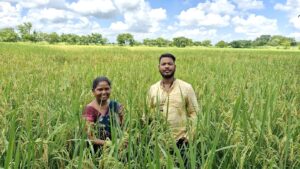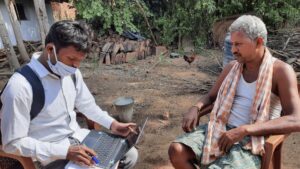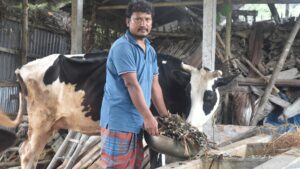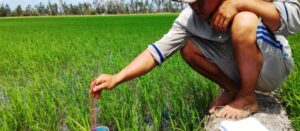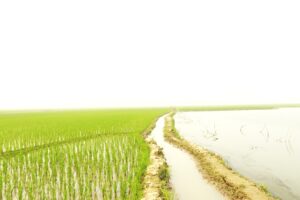by Swati Nayak*, Arabinda Kumar Padhee**, Sk Mosharaf Hossain*, Subhasmita Mahapatra* Dilip Kumar Rout*, Girija Prasad Swain*
(International Rice Research Institute*, **Department of Agriculture and Farmers Empowerment, Government of Odisha)
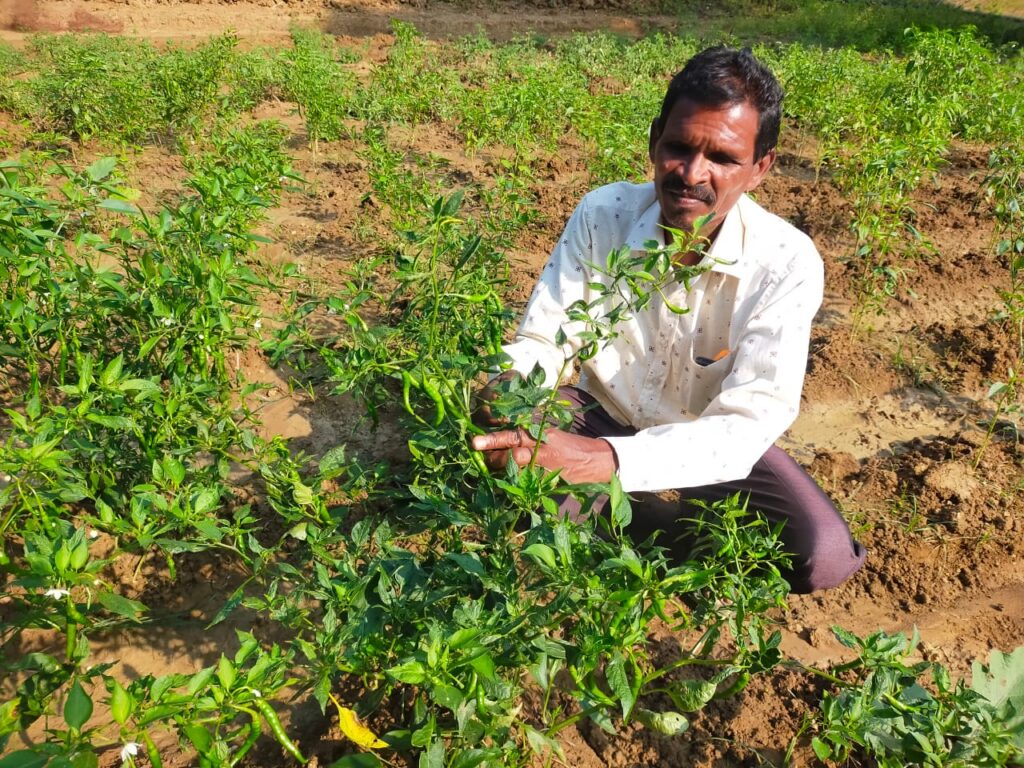
In Odisha, the eastern state of India, smallholder farmers are adapting and mitigating the challenges of drought through a unique collaborative effort by IRRI and the State Department of Agriculture and Farmers Empowerment. Supported through the Odisha State Disaster Management fund, the “Dynamics of Drought and Its Impact and Mitigation Options for Smallholder Farmers in Odisha” project opens new dimensions of integrating tailored mitigation strategies, innovation bundling, and a multi-stakeholder convergence model to help build resilience and promote behavioral change within farming communities.
Opportunities and Challenges in Odisha’s Agricultural Landscape
Odisha is India’s 13th largest economy with ₹8.3 lakh crore of Gross State Domestic Product (Odisha Economic Survey, 2024). It is also among the fastest-growing regions, with an 8.5% growth rate (Odisha Economic Survey, 2024). Agriculture and allied sectors form 21% of its Gross State Value Added (Odisha Economic Survey, 2024), sustaining 83% of the rural population and employing 61.8% of the workforce (State Agriculture Policy, 2022).
Paddy dominates crop production, with 11.9 million tonnes contributing to Odisha’s total food grain output of 14.1 million tons (Odisha Economic Survey, 2024). However, productivity lags at 2.3 t/ha, below the national average of 2.8 t/ha, and is far behind agriculturally leading states like Punjab (4.3 t/ha) and Haryana (3.8 t/ha) (Agriculture at a glance, GoI, 2022)
Reliance on rainfed systems and mono-cropping, compounded by frequent droughts and erratic rainfall, poses significant risks, particularly to the state’s 93% smallholder farmers (NSSO, 2019).
Responding to Drought Vulnerabilities
To tackle the challenges of drought, with the support and collaboration from Odisha’s State Department of Agriculture and Farmers’ Empowerment, the International Rice Research Institute (IRRI) is piloting a four-year project (2023–24 to 2026–27) titled Dynamics of Drought and Its Impact and Mitigation Options for Smallholder Farmers in Odisha. Funded by the State Disaster Mitigation Fund (SDMF) under Odisha State Disaster Management Authority (OSDMA), the project focuses on eight drought-prone villages across Bolangir, Mayurbhanj, Kalahandi, and Koraput districts for intensive piloting.
A baseline study of 16 villages—eight intervention and eight control—examined the socio-economic impacts of drought, farming practices, and vulnerabilities, informing tailored-fit action plans to address local needs.
Using a multi-stakeholder convergence model, the project aligns government schemes to boost farmers’ adaptive capacity through drought-tolerant crop varieties, diversified cropping systems, expanded irrigation, and improved livestock and horticulture management. These measures aim to build resilience and encourage behavioral change within farming communities.
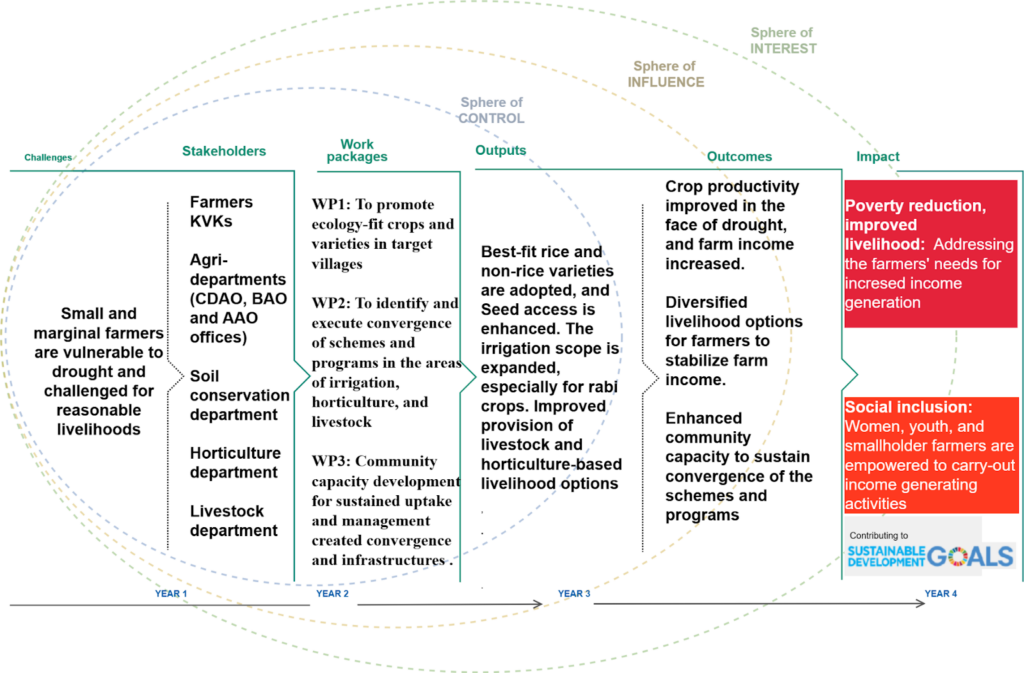
Localized Interventions Provided to Smallholder Farmers
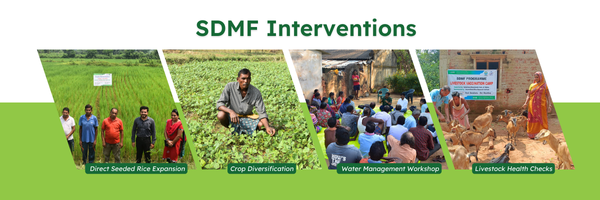
SDMF Program Interventions Field Photos (From Left to Right):
- Visiting Direct Seed Rice areas using varieties like Swarna Shreya and BRRI dhan 75.
- Teaching water budgeting and irrigation techniques to improve water management, enabling farmers to grow second crops, such as vegetables and pulses.
- Boosting livestock productivity through chick distribution, health check-ups, and vaccinations, in collaboration with the Department of Animal Husbandry.
- Encouraging sustainable farming practices with backyard gardens, and cultivating Kalahandi chili to diversify income sources.
Introduction and Selection of Drought-Tolerant Rice Varieties
Odisha’s predominantly rice-based cropping systems span upland, medium, and lowland ecosystems. As part of the project, 400 farmers participated in the demonstration of drought-resilient rice varieties across 90 hectares, while 240 received training in quality seed production to improve local access.
Drought-tolerant varieties like Swarna Shreya and PR 126 minimized risks during dry spells and enabled double cropping in uplands. High-yielding varieties such as Sabour Harshit were promoted for water efficiency and early maturity for medium lands. To further enhance water efficiency and reduce reliance on traditional flooded rice, the project introduced Aerobic Rice and Direct Seeded Rice (DSR). Demonstrations on 20 acres with 21 farmers highlighted the effectiveness of DSR-suitable varieties such as Swarna Shreya, PR 126, and Sabour Harshit.
Driving Direct Seeded Rice (DSR)
The project mobilized communities and demonstrated DSR across 25 hectares as a sustainable alternative to transplanted rice. Mechanized DSR, using seed drills and DSR-appropriate varieties like Swarna Shreya and BRRI dhan 75, motivated 141 farmers to expand the area under direct-seeded rice.
Enabling Crop Diversification
Post-rice pulses like green gram variety Virat and Arhar variety LRG 52 optimized residual soil moisture in lowlands. Intercropping cotton with pigeon peas in Bolangir and Kalahandi provided additional income and improved drought resilience. Seed support enabled 18 farmers in Kalahandi to grow millets on their marginal lands.
Expanding Irrigation Access
Expanding water access is a key initiative to boost productivity and diversify cropping systems. In Kalahandi, 25 farmers are organized into clusters to benefit from four subsidized lift irrigation facilities, enabling the cultivation of second crops like vegetables and pulses.
In addition, five ponds—three in Bolangir and two in Koraput—are planned in collaboration with the Soil Conservation Department to support rabi season crops. These ponds will also be integrated into the state’s farming system, promoting community-managed fisheries to enhance livelihoods and optimize resource use. A rain gauge has been installed in intervening villages to monitor village-level precipitation.
Improved Livestock Management
In all eight villages, livestock is a vital source of income and nutrition. Still, it faces low productivity and high mortality challenges due to limited access to improved breeds and timely vaccinations. To address these issues, IRRI, in collaboration with the Livestock Department, distributed 200 chicks in Mayurbhanj district, particularly to two Self-Help Groups (SHGs)—Maa Tarini SHG in Jhinei and Sawan Tulasi SHG in Tarajodi, Shyamakhunta—with support from KVK Mayurbhanj.
Furthermore, livestock health check-ups were conducted in Jhinei and Tarajodi in partnership with the Department of Animal Husbandry, vaccinating 853 animals across 87 households. These efforts aim to improve livestock productivity, prevent disease, and support animal well-being.
Horticulture and Kitchen Gardens
The baseline study identified significant opportunities to promote kitchen gardens, which were of strong interest to farmers in Kalahandi, Mayurbhanj, Bolangir, and Koraput. In collaboration with the Department of Horticulture under RKVY, IRRI supported 320 farmers from Kamthana and Gananathpur in Bhawanipatna, Kalahandi, by supplying seeds and materials to establish backyard kitchen gardens. These initiatives are designed to enhance household nutrition and create a marketable surplus, which local markets can accommodate.
To build on this potential, the project aims to establish 80 kitchen gardens by providing seeds, fencing materials, and agronomic guidance.
In the long run, the project will create the key outcomes of scheme convergence to support crop intensification and diversification to boost alternate livelihoods, resulting in enhanced adaptive capacity to counter drought vulnerabilities.
Navigating the Way Forward
Convergence with the ongoing government livelihood schemes is crucial for scaling the project’s impacts. In the coming seasons, the project will strengthen this alignment by leveraging resources and programs from the departments of water resources, horticulture, and animal husbandry. The emphasis will be more on convergence for scoping lift irrigation, developing pond-based water bodies, crop diversification, expanding areas under improved non-paddy crops, and assisting farmers in animal husbandry.
Focusing on rice-based cropping systems, the initiative aims to support smallholders in benefiting from complementary livelihood interventions. Enhanced adaptive capacity will reduce agricultural vulnerability, particularly in rice-based food production. Documented outcomes will serve as valuable evidence for broader stakeholder engagement and policy recommendations.
References
Government of Odisha. (2024). Odisha Economic Survey. Directorate of Economics and Statistics, Planning and Convergence Department. Retrieved from
https://pc.odisha.gov.in/sites/default/files/2024-07/OES%20Chapter_1%28Main%20Booklet%29_0.pdf
Government of Odisha. (2020). SAMRUDHI Agriculture Policy: 2020. Department of Agriculture & Farmers’ Empowerment, Government of Odisha. Retrieved from
https://www.nsws.gov.in/s3fs/2021-08/SAMRUDHI%20-Agriculture%20Policy%202020.pdf
Government of India. (2022). Agriculture Statistics at a Glance. Department of Agriculture & Farmers Welfare, Economics & Statistics Division. Retrieved from
https://agriwelfare.gov.in/Documents/CWWGDATA/Agricultural_Statistics_at_a_Glance_2022_0.pdf
National Sample Survey Office (NSSO). (2024). Situation Assessment of Agricultural Households and Land and Livestock Holdings of Households in Rural India, 2019. NSS Report No. 587, Ministry of Statistics and Programme Implementation. Retrieved from
https://mospi.gov.in/sites/default/files/publication_reports/Report_587m_0.pdf

